SeeDAO White Paper Digital City-State
SeeDAO White PaperAuthor: Tang Han, Bai Yu
After three months of discussion, writing, and revision, and after being approved by node voting, the SeeDAO whitepaper is finally released.
The birth of the whitepaper summarizes the community practice of SeeDAO from November 2021 to September 2023, with a scale of 12,000 people and 2,000 collaborators, and ultimately aims to build a society based on blockchain that pursues “a good life”. For this purpose, this is also a whitepaper without mathematical formulas.
The whitepaper signifies a tendency: to let Web3 move from finance to society, to people. Over the past decade or so, Web3 has been soaring in the field of finance and has achieved great success, but as the original purpose, it has been put aside. What this whitepaper wants to do is to bring back “people” and “life” and let Web3 return to life. Perhaps its vision is still immature compared to the vast social issues, but this step is incredibly important.
- JPEX bankruptcy, Hong Kong SFC plans to issue a blacklist for virtual asset exchanges.
- Crypto Security Differences Between Hacker Attacks and Fraud
- Conduit Elector Introduction How to bring high availability sorter and zero downtime deployment to Superchain?
For those who are concerned about the development roadmap and details of SeeDAO, if you don’t see the specific details you are interested in in this document, please don’t worry. Because the main purpose of this whitepaper is to clarify the vision of SeeDAO, to indicate what kind of digital city-state we want to build, why we want to build such a digital city-state, and the principles, materials, and tools for building this digital city-state. In short, it is about clarifying the path, material, ritual, law, and instrument of the city-state. This whitepaper serves a strategic role in SeeDAO and is the general outline of the city-state, so it will not involve too many specific details. After its release, the city-state will publish and update economic whitepapers, technical yellow papers, and community development orange papers according to its strategic stages to serve the development needs of the city-state.
Finally, we would like to express our deep gratitude to all the members involved in the whitepaper work and all the contributors who participated in the construction of SeeDAO. Although there are specific authors of this whitepaper, it is the result of the collective efforts of the working group members. Behind this document, there are also thousands of people’s questions and insights in practice. Without these people, the whitepaper would be just an empty castle in the air.
The following is the full text of the SeeDAO whitepaper:
Chapter 1: The Way of the City-State
Background
Since the birth of Bitcoin, we have had electronic currencies, financial infrastructure, DID, publishing facilities… The puzzle of building a network society has gradually emerged, and now we are only one step away, which is to piece these puzzles together.
However, immersed in the illusion of finance, we have been stagnant in this last step. For a long time, the practice of the Web3 industry has been to rely on financial means to acquire users, and the result is a swarm of financial parasites who come for money. When the wealth effect disappears, these financial parasites disappear like smoke, leaving behind technological shells that can never piece together the social map. Without a solid social network and corresponding demand, all kinds of dazzling Web3 products are like castles built on the beach, constantly at risk of collapse.
We have a strong need to build a solid network society, and now is the time to put these pieces together. This is not only because the technology sector is maturing, but also because the traditional geopolitical order that has lasted for thousands of years is collapsing. In the void and chaos, humanity calls for new forms of organization to explore a more valuable and meaningful life, ensuring broader freedom and happiness for people. The above is the background and reason for us to build this digital city-state called SeeDAO.
Significance
The significance of SeeDAO is to build a society on the blockchain that pursues a “good life” (happiness) as its goal. Its specific form is a digital city-state composed of a unified cyberspace and physical nodes distributed in different regions. In pursuit of the goal of a “good life,” the virtue of the city-state is reflected in three aspects: promoting connections between people, promoting personal inner discovery and emergence, and providing a beneficial public life for everyone.
The measure of happiness is the pleasure of body and mind, not just the amount of money and the level of technological development. Happiness points to a meaningful life, so it is not simply a personal matter. This is because the human mind cannot exist without others, and the meaning felt by people constantly emerges and confirms in the coexistence with the external environment and others. If there is a path to happiness, we believe it should be “coexistence, emergence, and freedom” in coexistence.
Coexistence is the premise of the city-state. The city-state is a network formed by different people connecting and interacting with each other. It is itself a dynamically evolving organism. The city-state is a place where meaning occurs, and it should create as many encounters and intersections as possible for its members. Collective collaboration is one of the most important ways. Any member of SeeDAO who joins the city-state should be aware that they are living in coexistence and presenting their existence in coexistence.
Emergence is the form of individual existence in the city-state. We believe that every person is born with their own “way” or destiny and nature. A good life should allow everyone to fully exert their nature, unfold their inner “way,” and fulfill their destiny. Emergence is the process of gradually unfolding and developing the individual’s “way” (inner order) in the city-state, and it is the necessary path to achieve individual freedom. Its three most obvious characteristics are action, work, and generative subjectivity.
“Action” is a fundamental characteristic of human beings. Humans do not live in a cold and rigid physical world, but in a series of events that they constantly understand and construct. With subjective agency and agency, people need to make choices in one event after another and participate in changing the world with their actions. We call this process “action.”
“Action” inevitably produces “works.” Each “work” has its own characteristics and can be evaluated by other members of the city-state. “Works” reflect the inner self of the “author,” and outstanding “works” can directly present the soul of the “author” and be passed down in the history of the city-state.
City-states will record the process and works of members as much as possible. Therefore, based on these records, individuals’ identities and roles in the city-state are dynamically generated according to their actions and works. The individual’s public reputation within the city-state should be related to their identity, as well as the welfare and accessible rights they can enjoy within the city-state.
When different individuals emerge in the coexistence, they may find conflicts and tensions between the realization of individual values. However, how to balance the intrinsic and extrinsic aspects of individuals, balance their own value propositions with those of the city-state, and pursue what their hearts desire without going beyond limits, coexisting in the city-state without being burdened by it, requires people to strive for “freedom”.
“Freedom” is the highest realm of freedom in a city-state. It symbolizes the harmony between a person’s spiritual and material, intrinsic and extrinsic aspects. Here, we use “freedom” instead of “liberty” to emphasize that the ultimate goal pursued by SeeDAO is happiness, rather than endlessly pursuing more options in material terms.
Chapter 2: The Composition of the City-State
The city-state is composed of people and things within its territory. Among them, people are the most important elements of the city-state, the source that enables the establishment and creation of the territory, and the ultimate goal of the city-state.
The city-state should have clear boundaries to determine whether someone is within the city-state. These boundaries are the identities bestowed upon individuals by the city-state. The city-state should have a clear account system that allows people both inside and outside the city-state to identify whether someone is a member of SeeDAO, and there should be a clear entry process for people to know how to become a member of the city-state. Since our understanding of happiness is based on individuals “creating” themselves in coexistence, the identity within the city-state should be generative, supporting individuals to dynamically generate their identities in SeeDAO through their actions and works, and obtain permissions within the city-state through this identity. This is mainly reflected in the NFTs, SBTs, liquidity tokens, and non-transferable points obtained by this individual in SeeDAO.
The territory of the city-state is composed of the network space, physical space, and the reality space formed by the overlay of physical and virtual aspects owned by the city-state. Territory refers to the field where people engage in activities, and its expansion and contraction are related to the needs of city-state members. Unlike physical space, the extensibility of network space is almost infinite, so it has significant differences in nature. However, because the people who engage in activities in network space and physical space are integrated, these spaces should be connected, and their history, currency, and permissions should maintain a certain consistency, so that they can be collectively recognized as public spaces of SeeDAO and operate according to the rules of the city-state.
The process of individuals connecting and “creating” themselves in the city-state is also a process of continuously creating works and things based on the public goods of the city-state. With the increase of members in the city-state, the demand for public goods will also continue to grow. Specifically, the main owners of the city-state’s things include: token assets in the public treasury, public physical assets in physical space, public knowledge assets in network space, public service equity assets in network and physical spaces, city-state historical data, etc.
The actions and events of SeeDAO members in the city-state constitute the history of SeeDAO. History includes changes in relationships between people, changes in ownership of things among different people, as well as the consumption, transfer, and creation of things. The history of SeeDAO is the greatest work collectively created by all members of SeeDAO, directly determining and presenting what SeeDAO is in practice. Therefore, SeeDAO is also dynamically generated in the history created by everyone together. Similarly, an individual’s history in SeeDAO is their greatest work in SeeDAO, determining and presenting their subjectivity within SeeDAO, directly affecting their “identity” in SeeDAO. As history is both the most basic consensus foundation for members to freely enter and exit SeeDAO, and also constitutes the ultimate meaning orientation for people, it has extraordinary significance in the city-state and is one of the most important public goods of the city-state.
Let us describe the importance of history to the city-state in this way: when there are still people creating history in the city-state, the city-state is alive; but when even the last person willing to maintain and synchronize the city-state’s history disappears, the city-state dies. The same is true for individuals. “Those who do not lose their place endure, those who do not forget after death live long” is the city-state’s stance on the philosophy of life.
Chapter 3: The Rites of the City-State
As discussed in Chapter 1: “The goodness of the city-state is manifested in three aspects: promoting connections between people, promoting internal discovery and emergence of individuals, and providing beneficial public life for all.” When all the elements of the city-state are complete, the basic stance of promoting the goodness of the city-state to the greatest extent should be taken to coordinate the relationships between the various elements of the city-state.
-
The relationship between individuals and the city-state
-
Freedom to enter and exit. That is, whether to join the city-state, whether to be active in the city-state, and whether to leave the city-state should be entirely voluntary for individual members. When individuals leave the city-state, the city-state should allow them to take away what belongs to them according to the rules. Because entering and exiting the city-state is completely free, individuals in the city-state need to take responsibility for their own choices and actions.
-
Generative subjectivity. An individual’s identity in the city-state is generated at any time based on their choices and actions. The city-state has a responsibility to record members’ various contributions to the city-state and distribute SeeDAO tokens, reputation values, NFT Seeds symbolizing core membership, and various SBTs according to the contributions, and generate personal identities of SeeDAO members based on various records.
-
Direct linkage between public services and personal identity. As the number of contributors in the city-state increases, the amount of public assets and public services created collectively will inevitably increase. It should be clear that the use of these public goods follows the principle of “everyone for me, me for everyone” and should be prioritized for contributors to the city-state, with those who make greater contributions enjoying more public services of the city-state.
-
Linkage between city-state governance rights and personal identity. This part follows the rules of SeeDAO’s meta-rules and governance manual.
-
The city-state provides individuals with as many beneficial connection opportunities as possible. This is reflected not only in expanding SeeDAO’s global network (including global interpersonal networks, spatial networks, and activity networks), but also in building a recognizable identity unity within SeeDAO’s territory, reducing the cost of trust based on this system.
-
The city-state encourages individuals to “do” and emerge. Works are a direct manifestation of a person’s soul; although there are differences in professions within the city-state, there is no difference in the ability of different professions to create outstanding works. The city-state should build a reputation system, social system, and historical evaluation system that can record and disseminate outstanding works of different professions within the city-state to promote individuals’ creation in their favorite fields.
-
The data created and accumulated by all members in SeeDAO (including identity data, social relationship data, city-state history, etc.) are the largest public assets of the city-state. The city-state has the responsibility to maintain these data and authorize other applications to use these data through legitimate mechanisms.
-
The relationship between organizations within the city-state
-
Within the city-state, individuals are free to form and dissolve workgroups within the city-state according to the corresponding rules.
-
Based on the relationship between the interests of organizations and the city-state as a whole, there are different degrees of distance between workgroups within the city-state. For example, the innermost part of the city-state is the city hall, incubator, and SeeDAO OS; followed by public projects and major guilds; then internally incubated commercial projects; and then external commercial projects seeking to enter SeeDAO (can be included in the observer list).
-
The city-state should organize the proximity to public interests, establish rules that different organizations within SeeDAO should follow and the rights they should enjoy. In principle, resources should be tilted towards organizations that are more relevant to the public interests of the city-state.
-
Since workgroups within SeeDAO are also growing at any time, their proximity to the public interests of the city-state is also changing. Regular reviews should be conducted to assess the status of workgroups in the city-state and update the map of proximity relationships in the city-state.
-
The city-state should provide corresponding technical infrastructure to allow SeeDAO members to identify what constitutes an organization within the city-state and the proximity relationship between these organizations and the city-state. In addition, since each member’s identity in the city-state is generated based on their own actions at any time, the proximity relationship between each person and different organizations (such as whether they have the authority to access a certain organization’s information database)
Chapter 4: The Laws of the City-State
Wherever people gather, there will be public affairs, and where there are public affairs, there will be public discussions. In the city-state, we refer to orderly public discussions, decisions, and actions as governance.
The purpose of governance is to maintain the operation of the city-state and promote its well-being. Since people are the most important element of the city-state and its ultimate goal, the maintenance of consensus and unity among the people is the most basic task of the governance.
Governance must be legitimate in order to be effective within the city-state. The SeeDAO Meta-Rules and their corresponding mechanisms are the fundamental source of legitimacy for all governance actors and actions within the city-state, and the Node Consensus Assembly is the highest governance body of the city-state.
The quality of governance can be measured by practical circumstances. The number of SeeDAO members, changes in public goods (such as the city-state’s territory, money in the treasury, technological infrastructure, data and history, public services and welfare, etc.), and the emergence of individual works created within SeeDAO can all reflect the state of the city-state. The quality of governance needs to be recorded in the city-state’s history.
If SeeDAO, the digital city-state, is compared to a game, then in this game, players will have four core assets: Liquid token $SEE, liquid NFT Seed, reputation points WANG, and SBT. Governance actors can use these tools in combination to govern different scenarios within the city-state. The following will explain these four types of assets:
Reputation Points WANG
WANG is the reputation points of SeeDAO, which reflects the members’ historical contributions to the city-state. Reputation points must be obtained through contributions to the city-state by community members, and the categorization and adjustment of contribution types and approaches are specified in the SeeDAO Governance Manual.
Reputation points are non-transferable and non-tradeable. The more reputation points one has, the more contributions they have made to SeeDAO and the closer their relationship with SeeDAO.
Reputation points have multiple uses within the city-state. For example:
-
Holders of reputation points of different levels have different levels of governance rights within the community;
-
When the reputation points exceed a certain threshold, the member can mint SeeDAO Seed NFT for free and enjoy various rights corresponding to the Seed;
-
Based on a member’s quarterly reputation points and decay formula, their current season’s effective governance points can be calculated to determine if they are eligible to participate in the Node Consensus Assembly;
-
…
Seed NFT
Seed is the identity symbol and cultural emblem of the core members of the city-state. The city-state does not sell Seeds to the outside world; the only way to mint Seed is for community members to accumulate reputation points within SeeDAO above a certain threshold.
Once the core members of the city-state have minted Seed, they can trade it on the market. After the Seed is sold, the community member no longer enjoys the various rights associated with the Seed.
In principle, participants in the SeeDAO Node Consensus Conference must be holders of Seeds. In addition, the community welfare of SeeDAO’s external negotiations and the public resources produced internally are prioritized for Seed holders.
SeeDAO SBT
Simply relying on homogeneous reputation points and non-homogeneous NFTs cannot fully present the appearance of community members in the community. Therefore, it is necessary to introduce various SBTs to describe the roles, skills, behaviors, and works of SeeDAO members.
SeeDAO SBT will be integrated into the identity system of SeeDAO members and become the material for community members to edit their self-image. At the same time, once a certain SBT (such as work experience SBT) is recognized by the outside world, it will bring new opportunities to the members and become a kind of identity asset.
$SEE
$SEE is the basic currency of the SeeDAO digital city-state, and all transactions that occur within the city-state should be conducted using $SEE as the payment method.
The legitimacy of $SEE as the payment method for transactions within the city-state is derived from the fact that the city-state provides public goods for everyone. Therefore, the issuance and destruction of $SEE is not fundamentally aimed at price appreciation, but at maintaining the sustainable supply of public goods within the city-state. If the price of $SEE is too low, the supply of public goods within the city-state will be difficult to maintain, and the city-state will also decline.
In the first phase, the total supply of $SEE is fixed at 1 billion. Among them, the total supply of community POW is 500 million, with a maximum annual release of 50 million, distributed over 10 years. After 10 years, the city-state will dynamically increase the issuance of $SEE based on the needs of adding or maintaining public goods.
For the public interest, the city-state needs to establish economic mechanisms to maintain the price of $SEE, including expanding the payment scenarios for $SEE (i.e. collecting coinage taxes from more people) and increasing the destruction scenarios for $SEE. In the destruction scenario, the most basic one is to tax and destroy commercial organizations that have accessed the city-state’s infrastructure and data, thereby reducing the total supply of $SEE. This process is automatically executed by the protocol and its implementation will depend on the SeeDAO OS detailed in Chapter 5. In principle, in the first phase of city-state development, the tax revenue collected by the city-state will flow back to the community treasury; in the second phase of city-state development, it will officially enter the destruction mode. The detailed content will be stipulated in the future released SeeDAO Economic Whitepaper.
The distribution of $SEE in the first phase will be introduced below:
-
Before $SEE Circulation
According to the current stage of the community node consensus conference and the three-tier proposal mechanism, the POW contribution of members is recorded and non-transferable on-chain points are distributed. At this stage, reputation tokens and $SEE are unified.
-
After $SEE Circulation, Before the City-State Public Chain Goes Live
Members who have obtained reputation points in the first phase will receive a 1:1 airdrop of $SEE. After that, $SEE enters the era of free circulation, and the distribution of reputation points WANG and the liquidity token $SEE are separated. At this time, the SeeDAO Economic Whitepaper should be released to elaborate on the economic model and calculation formulas for $SEE, reputation points WANG, and Seeds.
-
After the City-State Public Chain Goes Live, Before $SEE Enters Dynamic Supply
The ultimate form of SeeDAO in terms of technology is to build the city-state-specific public chain Polis. Polis will be used to carry out various economic activities of the city-state and provide secure and reliable chain services for various DApps and Apps. After Polis goes live, new contribution categories will be added to SeeDAO, and $SEE will be distributed to nodes participating in maintaining the Polis consensus mechanism. The SeeDAO Economic Whitepaper will be updated to adjust the economic model.
Chapter 5: City-State Instrument
The previous four chapters have elaborated on our various ideas, imagination, and needs for a digital city-state. To make these dreams come true, they need to be implemented in tangible technological objects, such as defining the territory of the city-state through technology, defining the identity and relationships of members, solidifying the public assets and tax base of SeeDAO, and reducing the living and creative costs of members within the city-state.
Currently, the most important infrastructure of the city-state is the SeeDAO OS and SeeDAO App, which enable the community to clearly define territory and member identities. This is the focus of this chapter. In the future, the most important infrastructure of SeeDAO will be its own public chain, Polis. At that time, there will be a dedicated technical whitepaper to introduce it.
In terms of their relationship, the public chain Polis is the essence, SeeDAO OS is the standard, and SeeDAO App is the presentation. Through these infrastructures, SeeDAO will achieve automation and gamification of member-city-state interaction experience, making life, creation, and governance within the city-state easier and more feasible.
SeeDAO Ecology
From a technical architecture perspective, the relationship between SeeDAO ecology and applications is shown in the following diagram: SeeDAO OS is at the bottom of the ecology, providing standards for building ecological applications; one level above is the city-state’s public goods, public services, and SeeDAO OS+ built on the OS; at the top are various services, city-state applications, and ecological applications for SeeDAO members.
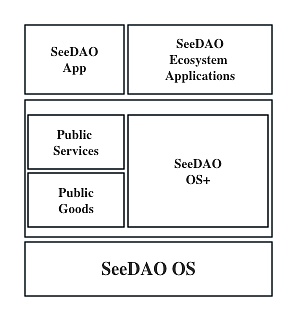
SeeDAO OS Architecture Overview
SeeDAO OS
In order to support the SeeDAO ecological applications, OS is designed to include two core subsystems: Protocols and Sidecar. Protocols are the foundation of SeeDAO OS and include Identity and Relationship protocols, allowing residents in the SeeDAO city-state to maintain consistent identities and relationships across different applications within the SeeDAO ecosystem. Sidecar provides the city-state’s core history recording capability and corresponding APIs, enabling accurate and persistent recording and retrieval of public life and development processes within the city-state.
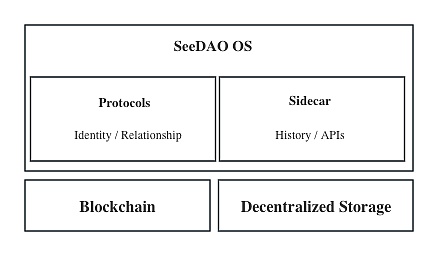
SeeDAO OS – Two LianGuairts
1. SeeDAO OS Protocols
The SeeDAO OS Protocols consist of two groups of protocols: Identity protocols and Relationship protocols.
The Identity protocols consist of the SeeDAO Name Service (SNS) and the Profile Protocol (SPP). When a person starts to have their own SeeDAO Name, their relationships and history can be recorded and acknowledged in the city-state’s technical system, which is the true gateway to the city-state. When this person starts to act within the city-state and leaves their traces and works, their personal page SeeLianGuaiSS (an application built on SPP) will also be updated accordingly. In respect for personal privacy, SeeLianGuaiSS will also provide anonymity to serve certain anonymous scenarios within the city-state.
The Relationship protocols (SeeDAO Relation Protocol, SRP) mainly involve the relationships between members and other people, objects, and events within the city-state, including social relationships and permission relationships. For example, whether Alice and Bob have ever worked in a certain working group within SeeDAO; whether Alice has permission to access the Shanghai city space of SeeDAO; whether Alice has permission to participate in community project reviews, etc. Through identity and relationships, we can determine the existence of a member within the city-state.
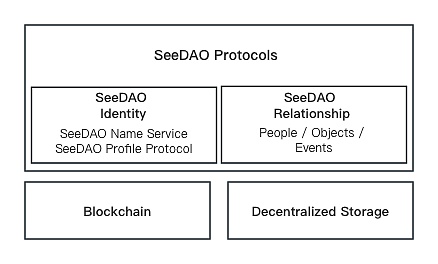
SeeDAO Protocols
2.SeeDAO OS Sidecar
The birth and death of identity, as well as the transformation of relationships between people, things, and events, constitute history. The ability to record, aggregate, and call history is placed in the Sidecar section outside the Protocol. In addition to history, Sidecar also provides capabilities such as data processing and access control. The data processing module can process, aggregate, and analyze the data generated by the vast city-state life, enabling the OS to constantly perceive the operation status of the city-state. The access control module provides unified, flexible, and open access management throughout the city-state life, providing a technical foundation for legitimate operations to authorize data to ecological applications.
In order to free people from heavy and repetitive work, SeeDAO OS Sidecar will also provide an Intent Engine to help people complete a large number of repetitive tasks in city-state life by combining AI and automated processes.
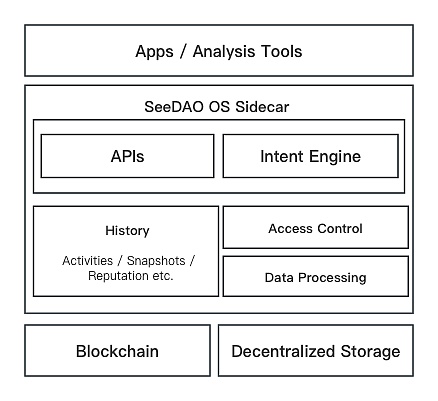
SeeDAO OS Sidecar
SeeDAO OS+
In order to promote the prosperity of SeeDAO ecological applications and reduce the development cost and difficulty of ecological applications, we have built SeeDAO OS+ based on SeeDAO OS and SeeDAO Open API.
As shown in the figure below, OS+ can provide fully developed technical solutions, providing support for web applications, mobile applications, desktop applications, and other platforms, ensuring that city-state life is online in different hardware environments and usage scenarios. We believe that applications within the city-state need to integrate Web3 and Web2 in many scenarios, and this state will exist for a considerable period of time in the history of technological development. Therefore, the technical solution of SeeDAO OS+ will support dApps, Apps, and Hybrid Apps. Hybrid Apps combine decentralized and centralized technological application forms, fully leveraging the advantages brought by the two technological directions while maintaining user experience.
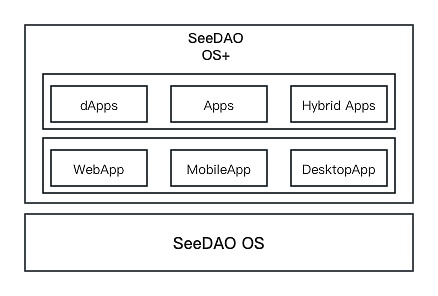
SeeDAO OS+
SeeDAO Public Utilities
Alongside SeeDAO OS+, there are application combinations that focus on public utilities, mainly divided into public goods and public services. Public goods are resources that members can obtain in the city-state without paying. For example, the proposal and voting system, although it has maintenance costs, members in the city-state can directly participate according to the corresponding rules without paying. Public services, although public in nature, can consider charging fees or distributing according to other rules, such as SNS, etc.
In SeeDAO, the establishment of public projects needs to strictly follow the corresponding rules of the city-state, while the ecological applications built based on OS+ are not restricted and can be published by anyone. Public utilities that prioritize public interests and unrestricted ecological applications built on the OS+ standard serve the life needs of city-state members. This not only guarantees the fairness of enjoying resources in city-state life but also promotes community emergence and accelerates ecological development.
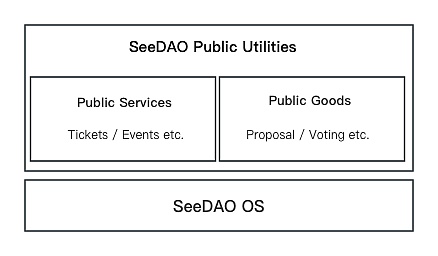
SeeDAO Public Utilities
SeeDAO App
For members, urban life needs to be visible and tangible. All applications, whether public goods, public services, or rich applications on OS+, need to be carried by specific things. In SeeDAO, this carrier is SeeDAO App.
All public goods and public services will be provided to members within SeeDAO App, and ecosystem applications on OS+ will also have an important presence in SeeDAO App. SeeDAO App not only provides web-based applications, but also provides mobile and desktop applications, allowing all urban residents to access their digital lives at any time.
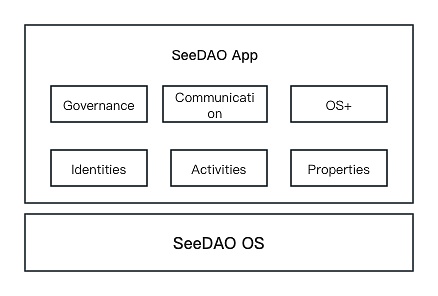
SeeDAO App
Polis: The Future Urban Public Chain
Although we will not discuss the urban public chain Polis in detail in this white paper, it is certain that as the number of people in the city-state expands and transactions occur in large quantities, we must reduce the unit cost of infrastructure usage. This requires us to build a dedicated chain for the city-state.
The launch of Polis will mark the completion of the city-state’s technological formation. From a community with nothing to a digital city-state, and then to the construction of a public chain that prospers with ecosystem applications, this plan sounds crazy but is so real in practice. Compared with projects that first receive huge capital to develop public chains and then develop ecosystems to attract users, our path seems different but ultimately converges. – one is from technology to society, and the other is from society to technology. We will eventually achieve the intersection of technology and society, weaving such a network society. And behind this, there is only one fundamental thing, and that is people.
After the launch of Polis, what will be waiting for SeeDAO? No one knows. But we will certainly not stop here. All along, the pace of SeeDAO’s progress has been very radical, but we are not afraid of being accused of being weavers of utopia. In any case, let us remember what was said in the first chapter, everything we do is to explore a more valuable and meaningful life, and to ensure broader freedom and happiness for people.
We will continue to update Blocking; if you have any questions or suggestions, please contact us!
Was this article helpful?
93 out of 132 found this helpful
Related articles
- Co-founder of AirBit Club Ponzi Scheme Sentenced to 12 Years in Prison
- LianGuaiWeb3.0 Daily | Binance will support the Celo (CELO) network upgrade and hard fork
- Multicoin Capital The Dawn of Fhenix and On-chain Fully Homomorphic Encryption
- The epitome of CEX behind OKB destruction The investment logic behind platform tokens
- Bybit’s suspension of operations is just the beginning an analysis of the UK’s new regulatory policies in October
- It’s time to have a discussion about the current state of the metaverse.
- Overview of the Latest Situation of Hong Kong’s First Licensed Virtual Asset Exchanges
-






